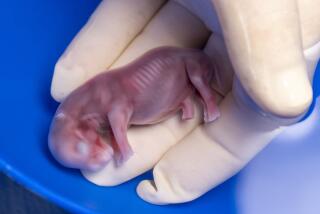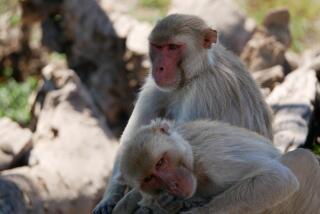DNA Transfer Crosses Species
- Share via
PORTLAND, Ore. — Moving medicine a big step closer to the day when healthier humans can be engineered in the laboratory, scientists have successfully transferred glowing green jellyfish DNA to monkey embryos.
Researchers previously did something similar with green jellyfish DNA and mice. In this latest experiment, scientists at the Oregon Regional Primate Research Center used rhesus monkey embryos instead, and produced a healthy, normal-looking monkey.
“When you get to a nonhuman primate, like a monkey, you’re getting much closer to people,” said Gerald Schatten, a cell biologist and professor of obstetrics at Oregon Health Sciences University who led the research. The university is a partner in the primate research center.
The scientists employed a technique adapted from fertility clinics, in which a tiny needle is used to insert sperm into an egg. In this case, the scientists first combined jellyfish DNA with monkey sperm and injected the sperm into a monkey egg.
Researchers said the experiment represents a big step toward the day when genes can be inserted into human embryos to correct or prevent diseases. As a result, the experiment has raised ethical concerns.
Schatten said he doubts the technique he used could be employed in such a way, and added that wasn’t the purpose of his research. He said the goal was to make fertility treatments safer by finding a more effective way to “clean” human sperm so that it does not carry a virus or bacteria into the egg. That has yet to be achieved by the monkey research.
“Normally when sperm enters the egg, it sheds its outer membrane the same way you might take off a raincoat,” Schatten said. “When you inject sperm, you send in the raincoat and anything riding on the raincoat. We want to make it kind of like a carwash.”
His research team chose the jellyfish gene for transfer because it is harmless and because its green glow makes it easy to track.
Seven embryos carrying the jellyfish DNA were transferred to rhesus monkeys, and one gave birth to a normal male. Scientists have not yet detected the genetic material in the monkey, but the birth itself was considered a success.
The work was reported last week in the journal Molecular Human Reproduction.
In May, scientists at the University of Hawaii reported that they had produced mice that actually glow green. The monkey research in Oregon moves genetic engineering closer to humans.
“It’s a lot closer to us than a mouse,” said Dr. Barry Zirkin, who heads the division of reproductive biology at Johns Hopkins University School of Public Health in Baltimore. “Sensible people should be having serious discussions about this right now.”
Dr. Ryuzo Yanagimachi, who pioneered the jellyfish DNA transfer to mice in Hawaii, said he believes it is only a matter of time until the technique is adapted to humans. “This can apply to humans eventually,” Yanagimachi said. “The monkey is kind of a bridge between animal and human.”
Critics were quick to warn against applying the technology to humans before more is learned about genetic structure.
“The thing that concerns me is that the field is really wide open. There is absolutely no regulation governing this field whatsoever,” said Alix Fano, spokeswoman for the Medical Research Modernization Committee, a nonprofit health advocacy organization in New York. “We’re really playing with fire in this whole field of genetic manipulation.”






